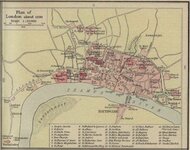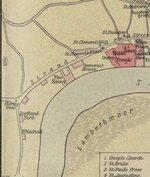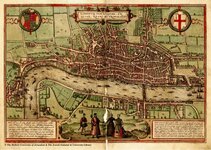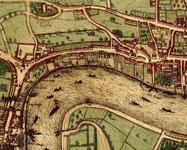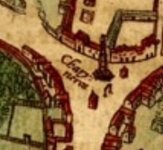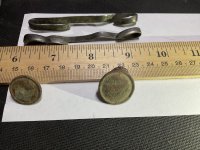You are using an out of date browser. It may not display this or other websites correctly.
You should upgrade or use an alternative browser.
You should upgrade or use an alternative browser.
the Charing Cross connection
- Thread starter lokiblossom
- Start date
New Gold
Full Member
lokiblossom
Bronze Member
- Thread starter
- #63
Check this one out. Very interesting:
View attachment 1094597
View attachment 1094598 View attachment 1094600
This map is from the 1500s, can anyone make out what it says for Charing Cross? Chary Nerox is what I see ....
You may have just blown my Charing Cross connection!
swiftfan
Sr. Member
Does anyone have a map of the twelve stops that were made with the remains? Is it possible that the map of the stops, overlaid of a map of Nova Scotia could indicate Oak Island and New Ross as having the same stops as the Queen's journey to London? Has anybody ever looked into this? Or is this stretching?
lokiblossom
Bronze Member
- Thread starter
- #65
You may have just blown my Charing Cross connection!
Maybe not, if I read it correctly (I'm looking at other versions) the word on the Map would be pronounced "Charing" or close to it. We know the site had the name Cyrringe in the 11th century (from the survey for Westminster, St. Peters) which probably evolved into the later spelling and we also know that the 12 memorials were called Eleanor Crosses, so a map would usually only indicate the location, but the object would have been pronounced "The Charing Cross". IMHO of course.
lokiblossom
Bronze Member
- Thread starter
- #66
Maybe not, if I read it correctly (I'm looking at other versions) the word on the Map would be pronounced "Charing" or close to it. We know the site had the name Cyrringe in the 11th century (from the survey for Westminster, St. Peters) which probably evolved into the later spelling and we also know that the 12 memorials were called Eleanor Crosses, so a map would usually only indicate the location, but the object would have been pronounced "The Charing Cross". IMHO of course.
Yep, got it now, thanks New Gold. The Templars would have pronounced the site, no matter how it was spelled, very close to Charing, or Charring, but after the memorial was erected (which they still would have watched being erected) they or anybody else would have called the memorial itself "The Cross at Charing". As Peele alluded to, Edward at the dedication had called it a memorial to his beloved Queen which is where the etymology of "Chere reine" would come in. Whether the Templars ever used the term Chere reine is no matter, as the Cross at Charing stood for a beloved Queen.
Eventually the site itself came to be called Charing Cross, which is mentioned in several maps, The Wyatt Rebellion and among other uses The Gunpowder Plot. The actual date this occurred is of little importance. All IMHO of course.
Smithbrown
Bronze Member
- May 22, 2006
- 1,002
- 831
New Gold. Your map dates from the 1920s. Mine dates from the 1980s. What happened in between? Well, to start, the Second World War. London was severely bombed. After this there was considerable rebuilding. This involved archaeologists being allowed in beforehand and many, many significant finds were made. This was followed by major periods of rebuilding, in the 1980s and 1990s, again involving archaeologists. In addition there was renewed interest in the history of cities in universities and new research was carried out and published into our medieval towns and cities. This changed our views of them. And what you have is from a general Atlas. My work is from a book specifically on the Topography of Medieval London.
By the by, did you look at the buildings along the Strand between Temple and Charing Cross on your 16th century map?
Swiftfan, you will find the route here: Eleanor cross - Wikipedia, the free encyclopedia But this is all one Big Red Herring, nothing to do with Templars, or Nova Scotia.
By the by, did you look at the buildings along the Strand between Temple and Charing Cross on your 16th century map?
Swiftfan, you will find the route here: Eleanor cross - Wikipedia, the free encyclopedia But this is all one Big Red Herring, nothing to do with Templars, or Nova Scotia.
lokiblossom
Bronze Member
- Thread starter
- #68
Does anyone have a map of the twelve stops that were made with the remains? Is it possible that the map of the stops, overlaid of a map of Nova Scotia could indicate Oak Island and New Ross as having the same stops as the Queen's journey to London? Has anybody ever looked into this? Or is this stretching?
I think that is stretching, although I do know of one person who makes a connection with the Lincoln Cross. Certainly the Templars were privy to the construction of the memorials as the Grand Master even had a seat in Parliament as a Baron, but IMHO the only link I can make is to the memorial that was located so close to Temple Church. Its doubtful if Edward I would have ever arrested any Templars in England, but his Son bowing to the pressures put on him by Pope Clement did eventually request they be arrested. In England those who were arrested were generally not treated as harshly as those in France.
It is noteworthy that English authorities were responsible for the only two Templar arrest in Scotland.
New Gold
Full Member
Smithbrown, as you can deduce from all these maps of London, the ninety-degree bend in the Thames is a very prominent topographical feature no matter what the time period.
It stands to reason that this bend in the river would have a name, beginning with "Cierring" which means turning, evolving into "Cherring" and eventually "Charing".
We know the Cross at Charing was placed in the early 1290s.
The name Charing Cross as seen in New Ross originated from before the settlement of Sherbrooke. The local native populations say that to them it was always Charing Cross.
So who named it? Offer up a plausible explanation for this naming in NS before the Scots and the Irish arrived.
No matter how many taverns and small churches separated them, the Cross in London was a prominent landmark located just down the street from the Temple Church.
It stands to reason that this bend in the river would have a name, beginning with "Cierring" which means turning, evolving into "Cherring" and eventually "Charing".
We know the Cross at Charing was placed in the early 1290s.
The name Charing Cross as seen in New Ross originated from before the settlement of Sherbrooke. The local native populations say that to them it was always Charing Cross.
So who named it? Offer up a plausible explanation for this naming in NS before the Scots and the Irish arrived.
No matter how many taverns and small churches separated them, the Cross in London was a prominent landmark located just down the street from the Temple Church.
lokiblossom
Bronze Member
- Thread starter
- #70
Just an fyi, The only Templars arrested in Scotland, were Walter de Clifton and William de Middleton, and the only reason this happened is Edward II of England had just invaded Southern Scotland in 1309 putting Balantrodoch (Scottish headquarters of the order) under English control. During the testimony of these two Knights at Holyrood abbey (also under English control) in December of 1309. they claimed they were the only Templars still in Scotland, and all the others had fled! Fled to where?
Loki
Loki
Eldo
Banned
- Jul 7, 2014
- 1,890
- 698
- Detector(s) used
- Brain, Pointing Finger, occasionally the Pinky Finger
- Primary Interest:
- All Treasure Hunting
Just an fyi, The only Templars arrested in Scotland, were Walter de Clifton and William de Middleton, and the only reason this happened is Edward II of England had just invaded Southern Scotland in 1309 putting Balantrodoch (Scottish headquarters of the order) under English control. During the testimony of these two Knights at Holyrood abbey (also under English control) in December of 1309. they claimed they were the only Templars still in Scotland, and all the others had fled! Fled to where?
Loki
What about the tales of working for Robert the Bruce......?
Could the two arrested have been sworn to secrecy to keep the location of their brothers safe....? Yes.
If they were the only ones......why didn't they flee ?
Sounds more like they sent some lower order knights to do some trade, pick up supplies, or do some messenger work for the Bruce......and got caught. There were others.....
lokiblossom
Bronze Member
- Thread starter
- #72
What about the tales of working for Robert the Bruce......?
Could the two arrested have been sworn to secrecy to keep the location of their brothers safe....? Yes.
If they were the only ones......why didn't they flee ?
Sounds more like they sent some lower order knights to do some trade, pick up supplies, or do some messenger work for the Bruce......and got caught. There were others.....
In 1309 the English holdings in Scotland were only a few southern castles. Any Templars who had escaped France and traveled to Scotland and still in Scotland in 1309 would be in hiding. And of course we have the Knights of the "inner circle" of whom I premise many went to Nova Scotia. As for Robert the Bruce, he is known to have had a secret meeting at Ardchattan Priory in 1308, where I claim that the Knights of this inner circle spent the winter of 1307-1308. Certainly the two captured brothers could have been protecting the others and when all was said and done they were simply released.
As for Bannockburn in 1314, history says camp followers and servants made up the reserve force that turned the tide of the battle! But we can't always believe history can we?
Smithbrown
Bronze Member
- May 22, 2006
- 1,002
- 831
New Gold. Please give a reference for the name Charing Cross dating before the colonization in the 18-19th century. A proper book, preferably. The trouble with the statement "The local native populations say that to them it was always Charing Cross" could easily only refer back a generation or two. Savoy Palace was really much closer than the mile walk down to Charing Cross.
lokiblossom
Bronze Member
- Thread starter
- #74
New Gold. Please give a reference for the name Charing Cross dating before the colonization in the 18-19th century. A proper book, preferably. The trouble with the statement "The local native populations say that to them it was always Charing Cross" could easily only refer back a generation or two. Savoy Palace was really much closer than the mile walk down to Charing Cross.
If I had proof that the name Charing Cross in Nova Scotia predated known European settlement it wouldn't be a premise would it? Perhaps you could show a reference that shows (proves) the origin of the Name Charing Cross in Nova Scotia.
And if you read my amended statement you will see that I do agree that the Savoy was closer to Temple Church then Charing Cross. But even at that the Templars would have watched the construction of the memorial from their doorstep.
cheers, Loki
Smithbrown
Bronze Member
- May 22, 2006
- 1,002
- 831
Not at almost a mile they wouldn't! Unless their eyesight was exceptionally good! Not to mention all those proprieties which you can't be bothered checking up. You, Lokiblossom, are the one making the claims. You are supposed to prove them.
On a different tack, since the Templars had been so pro-English occupation and conquest of Scotland (two Masters killed at the Battle of Falkirk), why would the Scots have suddenly welcomed them in?
On a different tack, since the Templars had been so pro-English occupation and conquest of Scotland (two Masters killed at the Battle of Falkirk), why would the Scots have suddenly welcomed them in?
lokiblossom
Bronze Member
- Thread starter
- #76
Not at almost a mile they wouldn't! Unless their eyesight was exceptionally good! Not to mention all those proprieties which you can't be bothered checking up. You, Lokiblossom, are the one making the claims. You are supposed to prove them.
On a different tack, since the Templars had been so pro-English occupation and conquest of Scotland (two Masters killed at the Battle of Falkirk), why would the Scots have suddenly welcomed them in?
That's too bad about your eyes, have you checked into glasses? And I did make the amended claim that Savoy house was between temple Church and Charing Cross, but did not block the view of the memorial being built from Temple Church property. You say that isn't true so you prove your point, and post the facts here. If you are a worthy detractor that is what you should do IMHO.
It was against one of the most important of the Orders rules to fight against another Christian, but this is a rule that was broken from time to time. Even though Wallace was defeated at Falkirk, you don't think Robert would welcome any Templars that had fought with the English that would switch allegiance. And don't forget that "the Bruce" had recently been excommunicated by the same Pope who was helping to persecute the Templars. Also there is the fact that there were already many Scottish brothers in Scotland. Remember the secret Parliament held by Robert the Bruce in 1308 at Ardchattan?
Most of the members of the inner circle, the unit that I premise was responsible for the treasures of the temple and the Holy Grail, were French Knights escaping from the attempted arrests in that country.
Smithbrown
Bronze Member
- May 22, 2006
- 1,002
- 831
I gave you a list of properties between Temple Church and Charing Cross, way back in the mists of time. IMHO you are the one in need of sharpening their research skills; I gave you the names, check them out yourself. I assume you won't do that because it disproves your point.
No, I hadn't forgotten the "secret parliament". So secret that most historians don't think it happened. Most agree Bruce's first parliament was held at St Andrews in 1309. There is no contemporary evidence for Bruce meeting any Templar in Ardchattan. How many Scottish brothers do you think there were? I suspect you are overestimating the numbers. The Templar estates in England were more numerous and wealthy than the Scottish estates, which were not helped by a decade of Civil War.
So what language are all these knights speaking?
No, I hadn't forgotten the "secret parliament". So secret that most historians don't think it happened. Most agree Bruce's first parliament was held at St Andrews in 1309. There is no contemporary evidence for Bruce meeting any Templar in Ardchattan. How many Scottish brothers do you think there were? I suspect you are overestimating the numbers. The Templar estates in England were more numerous and wealthy than the Scottish estates, which were not helped by a decade of Civil War.
So what language are all these knights speaking?
lokiblossom
Bronze Member
- Thread starter
- #78
I gave you a list of properties between Temple Church and Charing Cross, way back in the mists of time. IMHO you are the one in need of sharpening their research skills; I gave you the names, check them out yourself. I assume you won't do that because it disproves your point.
No, I hadn't forgotten the "secret parliament". So secret that most historians don't think it happened. Most agree Bruce's first parliament was held at St Andrews in 1309. There is no contemporary evidence for Bruce meeting any Templar in Ardchattan. How many Scottish brothers do you think there were? I suspect you are overestimating the numbers. The Templar estates in England were more numerous and wealthy than the Scottish estates, which were not helped by a decade of Civil War.
So what language are all these knights speaking?
The reference you gave for your list of properties as far as I can tell was from a map dated 1520, please correct me if I am wrong, but I don't have a Mary D. Lobel book in my library. Perhaps you could post the map you are referring to? As for your 11th century tube map, which you correctly state is newer then that date because of the reference to Temple Church (1161), it shows nothing between the Temple Church area and Cyrringe.
The language used at the so-called secret parliament was supposed to be "Gaelic", and there are enough legendary references to it to assume that it did occur (as well as being mentioned in the New Catholic Encyclopedia). There is evidence of a 14th century Templar presence at Ardchattan and also legends to that effect. Although legends do not always prove true there are many times an earlier basis in fact.
Ardchattan itself (a few miles from where my family came from) was Cistercian in nature, which is the Order the Templars were founded in. In the late fall of 1307 it is unlikely if any of the brothers at Ardchattan knew of the events in France and they would have gladly helped French Templars winter and resupply their ships, IMHO of course.
And I should add that with having a seat in English Parliament the Templars would have been greatly interested in the erection of the memorial at Cyrringe to Eleanor. They would have watched it being built from Temple Church and attended the dedication by Edward I of this Cross to the memory of his "Beloved Queen".
Smithbrown
Bronze Member
- May 22, 2006
- 1,002
- 831
Always happy to correct you, Lokiblossom. The book contains two maps and a gazateer. I checked the gazateer for properties in existence by 1300. Then cross-referenced to the appropriate volumes of the Survey of London (1900 onwards).
The medieval underground map contains almost no buildings in the City of London itself. Would you seriously use this evidence to suggest the city was an empty space? Talk about straw-clutching!
I was referring to the language of the Templars, not the "secret parliament".
Can you give us the references to the Templar at Ardchattan? And to these assorted legends. It would be useful to see how far back these legends existed.
Still happy to correct you, Loki. Ardchattan is a Valliscaulian house.
Which Knights Templar sat in which of Edward's Parliaments? I don't quite follow the logic of the statement. The easiest way from Temple Church to Westminster is by river rather than along the Strand.
The medieval underground map contains almost no buildings in the City of London itself. Would you seriously use this evidence to suggest the city was an empty space? Talk about straw-clutching!
I was referring to the language of the Templars, not the "secret parliament".
Can you give us the references to the Templar at Ardchattan? And to these assorted legends. It would be useful to see how far back these legends existed.
Still happy to correct you, Loki. Ardchattan is a Valliscaulian house.
Which Knights Templar sat in which of Edward's Parliaments? I don't quite follow the logic of the statement. The easiest way from Temple Church to Westminster is by river rather than along the Strand.
lokiblossom
Bronze Member
- Thread starter
- #80
Always happy to correct you, Lokiblossom. The book contains two maps and a gazateer. I checked the gazateer for properties in existence by 1300. Then cross-referenced to the appropriate volumes of the Survey of London (1900 onwards).
The medieval underground map contains almost no buildings in the City of London itself. Would you seriously use this evidence to suggest the city was an empty space? Talk about straw-clutching!
I was referring to the language of the Templars, not the "secret parliament".
Can you give us the references to the Templar at Ardchattan? And to these assorted legends. It would be useful to see how far back these legends existed.
Still happy to correct you, Loki. Ardchattan is a Valliscaulian house.
Which Knights Templar sat in which of Edward's Parliaments? I don't quite follow the logic of the statement. The easiest way from Temple Church to Westminster is by river rather than along the Strand.
The Templars that would have wintered at Ardchattan were mostly French and I don't know what language they would have used. I do know that most were at least bilingual as I would assume was also the Bruce.
I did not say Ardchattan was a Cistercian house, I said it was Cistercian in nature! And Ardchattan is not now a Valliscaulian house, it is a private residence.
The Valliscaulian order was absorbed back into the Cistercian Order in the 18th century. The Valliscaulian's were an offshoot of the Cistercian's using most of the same rules
The Grand Master of the Knight's Templar had a seat in Parliament as a Baron. And I don't think that getting on a boat and rowing up the Thames would be easier then having your servant saddle a horse and ride there along the street that in your mind was probably paved.
I guess I will look further into the houses along the Strand, not that I don't believe you of course.
Last edited:
Top Member Reactions
-
 2605
2605 -
 1181
1181 -
 1076
1076 -
 890
890 -
 862
862 -
 842
842 -
 792
792 -
 678
678 -
 645
645 -
 611
611 -
 496
496 -
 477
477 -
 476
476 -
 471
471 -
 464
464 -
 431
431 -
O
405
-
 397
397 -
 384
384 -
 382
382
Users who are viewing this thread
Total: 2 (members: 0, guests: 2)
